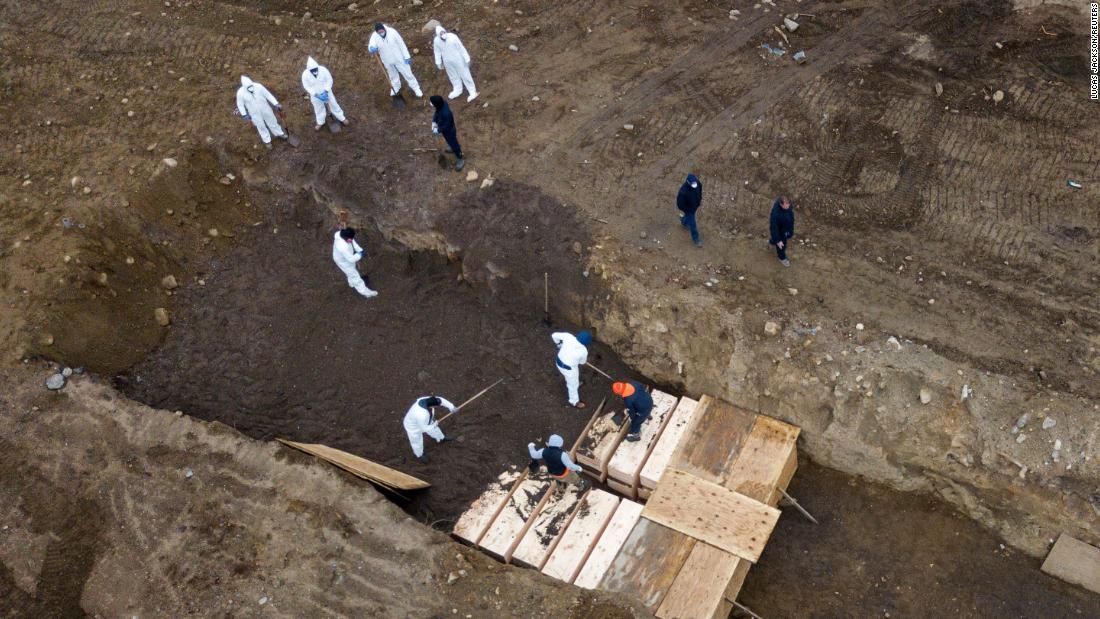[ad_1]
The victims wheeled from packed morgues and stored in refrigerated trailers outside hospitals. No mourning at houses of worship, funeral homes or cemeteries.
Mayor Bill de Blasio responded to concerns that mass burials would be necessary because of the high number of bodies from the pandemic. Lines of caskets could be seen being covered with dirt in long trenches on the island earlier this month in drone video posted by the nonprofit.
“There will be no mass burials on Hart Island,” de Blasio tweeted Friday. “Everything will be individual and every body will be treated with dignity.”
Hunt responded to the mayor via Twitter on Saturday, saying Hart Island burials are no longer handled by inmates at Rikers Island.
“There is not enough testing to know how many people buried died of complications from COVID-19,” she wrote. “You need to visit Hart Island and honor the buried. Many families have no choice.”
‘A very sacred place’
The city purchased Hart Island in 1868 and turned it into a public cemetery. Over 150 years, the island served as a burial ground for victims of the 1918 Spanish Flu pandemic and the AIDS epidemic in the 1980s. It was a prison workhouse, a union solider training site, and prisoner of war camp for Confederate fighters. It has harbored yellow fever and tuberculosis victims.
More than a million New Yorkers have been laid to rest on the small strip of land off the coast of the Bronx — soldiers, the poor and the unclaimed, the homeless and stillborn babies.
“The thing the politicians should be doing is talking about Hart Island differently because it’s the largest natural burial ground in the United States,” Hunt said. “It’s a really beautiful location and it’s already transferred to Parks and they will take over in July 2021 and they will turn into a beautiful place.”
The city Department of Correction has long managed the island, paying Rikers inmates to handle the public burials as part of their work detail. Last year, the city decided to turn over control to Parks though DOC still manages the property and interments.
The city has said DOC is using contracted workers to carry out the burials.
“There’s a lot of wildlife out there,” Hunt said. “It’s a bird sanctuary. It’s a very, very peaceful location. And the fact there aren’t individual monuments is part of the spiritual power of the place, knowing that over a million New Yorkers have been buried there.”
Mayor vows ‘every measure of respect and dignity New York City can provide’
Freddi Goldstein, the mayor’s press secretary, said about 25 people were buried on the island each week. Now there are 25 burials per day.
The city is transferring unclaimed bodies to the 101-acre island to make way for coronavirus victims whose bodies are claimed, according to Goldstein. New rules will require bodies to be taken to the island if they go unclaimed for two weeks.
“These are people who, for two weeks, we have not been able to find anyone who says, ‘I know that person, I love that person, I will handle the burial,'” Goldstein said.
The mayor tweeted, “The heartbreaking numbers of deaths we’re seeing means we are sadly losing more people without family or friends to bury them privately. Those are the people who will be buried on Hart Island, with every measure of respect and dignity New York City can provide.”
The bodies arrive by ferry from City Island in the Bronx. They’re carried in plain wooden coffins and stacked three high and two across in trenches. Rikers’ inmates would shovel over the coffins with dirt in unmarked mass graves. The private contractors will use a forklift and other heavy machinery for the burials.
“A decent burial does not involve prison inmates burying your loved one,” Hunt said.
The island’s burial system has evolved over 150 years.
“It goes all the way back to the Civil War, with the Union army having to bury huge numbers of soldiers on battlefields in the South,” Hunt said. “They had to do with these ledgers and this grid system such that they could come back later to disinter and rebury in national cemeteries.”
Only people who have not been claimed by relatives or a loved one will be buried on the island, Goldstein said. As long as morgue officials make contact with a relative within 14 days, they will not be moved to Hart Island.
Hunt called the grid system for the burials “tried and tested.”
“There’s no real choice here,” Hunt said. “This is where the majority of Covid-19 victims are going to be buried. It disproportionately affects the low income community who can’t really isolate and avoid using the subways. By the same token those same people can’t afford a funeral.”
She called Hart Island “a meaningful place in a dark time.”
[ad_2]
Source link


